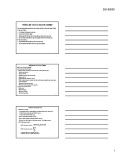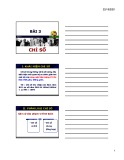Chapter 1
An Introduction to Business Statistics
McGrawHill/Irwin
Copyright © 2014 by The McGrawHill Companies, Inc. All rights reserved.
An Introduction to Business Statistics
1.1 Data 1.2 Data Sources 1.3 Populations and Samples 1.4 Three Case Studies that Illustrate Sampling and Statistical Inference 1.5 Ratio, Interval, Ordinal, and Nominative Scales of Measurement (Optional)
12
LO1-1: Explain what a variable is.
1.1 Data
conclusions can be drawn
Data: facts and figures from which
particular study ◦Elements: may be people, objects, events, or
other entries
Data set: the data that are collected for a
13
Variable: any characteristic of an element
LO1-2: Describe the difference between a quantitative variable and a qualitative variable.
Data Continued
variable to the element
Measurement: A way to assign a value of a
Quantitative: the possible measurements of the values of a variable are numbers that represent quantities
into several categories
14
Qualitative: the possible measurements fall
LO1-3: Describe the difference between cross-sectional data and time series data.
CrossSectional Data
Crosssectional data: Data collected at the same or approximately the same point in time
different time periods
15
Time series data: data collected over
LO1-4: Construct and interpret a time series (runs) plot.
Time Series Data
16
Table 1.2 and Figure 1.1
LO1-5: Describe the different types of data sources: existing data sources, experimental studies, and observational studies.
1.2 Data Sources
Existing sources: data already gathered by public or
private sources ◦Internet ◦Library ◦Private data sources
Experimental and observational studies: data we
collect ourselves for a specific purpose ◦Response variable: variable of interest ◦Factors: other variables related to response variable
17
LO1-6: Describe the difference between a population and a sample.
1.3 Populations and Samples
Population
The set of all elements about which we wish to draw conclusions (people, objects or events)
Census
An examination of the entire population of measurements
Sample
A selected subset of the units of a population
18
LO1-7: Distinguish between descriptive statistics and statistical inference.
Descriptive Statistics and Statistical Inference
describing the important aspects of a set of measurements
Descriptive statistics: the science of
sample of measurements to make generalizations about the important aspects of a population of measurements
19
Statistical inference: the science of using a
LO1-8: Explain the importance of random sampling.
1.4 Three Case Studies That Illustrate Sampling and Statistical Inference
New Bottle Design
1. Estimating Cell Phone Costs 2. The Marketing Research Case: Rating a
110
3. The Car Mileage Case: Estimating Mileage
LO1-9: Identify ratio, interval, ordinal, and nominative scales of measurement (optional).
1.5 Ratio, Interval, Ordinal, and Nominative Scales of Measurement (Optional)
Quantitative variables
◦Ratio variable: a quantitative variable measured on a scale such that ratios of its value are meaningful and there is an inherently defined zero value
◦Interval variable: a quantitative variable where ratios are
not meaningful and there is no defined zero
Qualitative variables (categorical)
◦Ordinal variable: a qualitative variable for which there is
a meaningful ranking of the categories
◦Nominative variable: a qualitative variable for which
there is no meaningful ranking of the categories
111


























